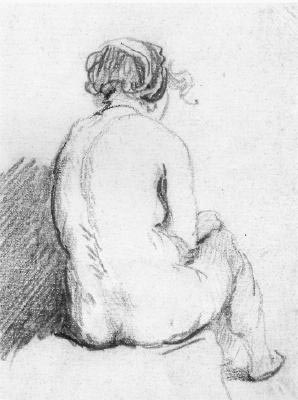 |
| Juliet D Collins, Study for Sarong, 2012 |
Life drawing is at the heart of all the art I make. This is more obvious with my thread and fabric work, each one of which has been developed directly from my life drawings. But it is also a very important element in my sculpture - my studies from the life model have always had a great influence on my ideas, designs and the development of the forms I create. So I thought I'd write a little bit about life drawing - a whistle-stop tour through some of history's greatest artists who have practised & developed the tradition of this inspiring art form and why I feel it is important and relevant to draw the human form from life.
Artists have been drawing from the live nude model at least since the time of the Italian Renaissance. They began doing so in a quest to understand the human body better and to define the ideal proportions of the body. This era gave birth to the study of Anatomy. It is a well known fact that artists such as Leonardo da Vinci were illegally dissecting dead bodies in order to study their anatomy at this time. During the Renaissance the aim was to depict the idealised human form, to perfect nature in an attempt to convey the divine and to emulate the classical art of ancient Greece.
 |
| Leonardo da Vinci's Vetruvian Man 1487 |
 |
| Leonardo da Vinci, drawing, anatomy of a male nude 1504-1506 |
Artist such as Rembrandt - working in the 17th century -perfected drawing skills through careful observation and practise. Rembrandt considered his drawings from life to be a private record of his observations. His ability to depict the human form so accurately, with great economy of line and in a manner that conveys spontaneity and emotion, is just one of the reasons his works and skills are so very highly regarded.
 |
| Rembrandt, Sitting Woman |
By the 19th century artists had replaced the aim of conveying divine and idealised perfection for the pursuit of realism. Toulouse Lautrec and his contemporaries relished in depicting everyday moments of the ordinary people around them.
 |
| Henri de Toulouse-Lautrec, Woman Sleeping |
Egon Schiele is one of my favourite artists. Working in the early 20th century he is known for his intense and expressionist style. I'll need to devote a whole post to him at some point!
 |
| Egon Schiele, Sitzender weiblicher Akt mit aufgestützen Ellbogen, 1914 |
 |
| Matisse, drawing |
I believe so. The human body is generally thought to contain every aspect of form, visual complexity and subtlety that an artist will ever encounter. The figure represents many technical challenges – form, structure, foreshortening, proportion and also allows us to express a great deal about human nature, to express mood personality and deep emotion.
Drawing the human figure regularly helps one to improve one's powers of observation and drawing skills. With practice, it allows us the opportunity to rise above our inner critic and gain skillful artistic mastery which we can apply to any artform we wish pursue.
Above all, life drawing is a wonderful, challenging, frustrating, joyful, sometimes painful and ultimately very rewarding artistic endeavour which can produce stunning works of art.
No comments:
Post a Comment